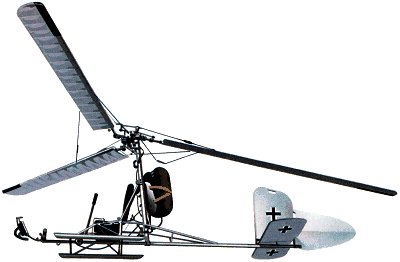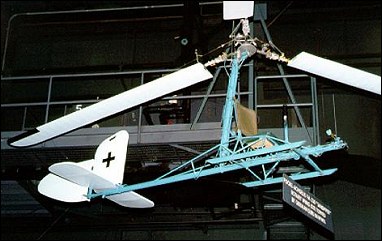|
|
By the end of World War II, some 200 of these small, motorless, three-bladed autogyros had been built for Focke Achgelis by the Weser Flugzeugwerke at Delmenhorst. This rotorcraft was flown as a kite towed by a submarine from a cable 60 to 150 metres in length. The collapsible assembly was made of steel tubes, and just behind the pilot's seat was a pylon to support the rotor. The latter's hub was of the simplest possible autogyro type with flapping and drag hinges. The rotor was set in motion by a rope or by hand alone, if there was sufficient wind blowing. To bring the autogyro back, the towing rope was pulled in by winch, and when the aircraft landed the rotor was brought to a standstill with a brake.
Training to handle this autogyro was given in a wind tunnel at Ghalais Meudon in France. An original Fa 330 is still preserved in the French Air Museum. P.Lambermont "Helicopters and Autogyros of the World", 1958

Early in 1942, Focke Achgelis at Laupheim were asked to design a simple single-seat gyro kite which surfaced U-boats could tow aloft to extend the observer's range of view. At this time, the U-boats were being forced away from the dense shipping areas around the coasts of Britain and the United States to hunt further out into the Atlantic where there was greater safety, but where their low position in the water made searching for, and shadowing, the spread-out convoys a very difficult task unless a bosun's chair could be attached to the periscope.
The gyro kite, designated Fa 330 Bachstelze, was seen as some sort of solution and ingenuity was shown in its design. The machine could be easily assembled or dismantled in a few minutes and stowed through a U-boat hatch. The body structure consisted of two main steel tubes, one horizontal and one vertical. On the horizontal tube was mounted the pilot's seat with controls and a small instrument panel, and landing skids, and, at the rear end, a simple tailplane, fin and rudder. The vertical tube, behind the pilot's seat, formed a pylon for the rotor.
The freely-rotating rotor had three blades, each of which consisted of a tubular-steel spar with plywood ribs and thin plywood and fabric covering. Each rotor blade had flapping and dragging hinges with adjustable dampers. Blade pitch could only be adjusted, with screws, on the ground before take-off. The best results were normally obtained with the blade pitch as coarse as possible, although starting was then more difficult. In addition to the flapping and dragging dampers, there were also inter blade connecting cables and blade-droop cables, the latter being attached to the blades and to an inverted tripod extending upward from the rotor hub. The rotor axis was slightly ahead of the machine's c of G, and the towing cable attachment point was slightly ahead and below the c of G.
Movement of the control column tilted the rotor head in the appropriate direction for longitudinal and lateral control, and operation of the rudder pedals gave directional control. The tailplane was not adjustable. The Fa 330 was launched from the deck of the surface-running U-boat by giving the machine a slight backwards tilt once the rotor was revolving. If there was a wind, a push by hand sufficed to get the rotor moving, but otherwise a pull-rope was wound around a grooved drum on the rotor hub. In case this rope did not slip off when the rotor started, an over-ride mechanism was fitted.
Pilot training was given in a wind-tunnel at Chalais-Meudon near Paris, and the kite was very easy to operate and could be flown hands-off for up to 10 seconds. It is believed that two or three crew members of each Fa 330 equipped U-boat learned to fly it.
Having 150m of towing cable available, it was possible to maintain an altitude of 120m thereby extending the possible range of vision very usefully to 40km compared with only 8km on the U-boat deck. In an emergency, the pilot, who had telephone contact with the U-boat, pulled a lever over his head which jettisoned the rotor and released the towing cable. As the rotor flew away and up, it pulled out a parachute mounted behind the pylon. At this stage, the pilot, attached to the parachute, unfastened his safety belt to allow the remainder of the Fa 330 to fall into the sea while he made a normal parachute descent. In a normal descent, the kite was winched in to the deck and, upon landing, the rotor brake applied.
Although designed by Focke Achgelis, the Fa 330 was built by the Weser-Flugzeugbau at Hoykenkamp, near Bremen. This particular factory manufactured Focke-Wulf Fw 190 fuselages, a few Fa 223 helicopters and about two hundred Fa 330s. Variations made in the basic design were an increase in rotor diameter to 8.53m on late machines and the option of adding simple landing wheels to the skids. There was also a proposal, designated Fa 336, to build a powered version of the Fa 330 with landing wheels and a 60hp engine.
The principal U-boat class to use the Fa 330 was the ocean-going Type IX which had a surface displacement of 740 tons, a surface speed of 18kt and a submerged speed of 7.5kt. Among the operational U-boats of the Kriegsmarine, only the Type IX-D/2 supply U-boat had a faster surface speed of 19.2kt, and this type possibly used the Fa 330 also. Little is known of actual operations with the kite, or how many were issued, but there is no doubt that the use of the gyro kite was unpopular, because, in an emergency, the U-boat had either to delay its dive in order to pick up the kite's pilot, or dive and hope to pick him up later. The advantages of a self-propelled machine seem clear. The first Fa 330s were probably issued in mid 1942 but were used in the South Atlantic only on rare occasions. From June 1942, the harried U-boat forces swung their main effort from the Atlantic to the Gulf of Aden and the Indian Ocean, where more use of the gyro kite was made. U-861, for example, used her kite on a patrol in the Indian Ocean off Madagascar. However, the new theatre of operations provided opportunities to exchange the Fa 330 for, in the eyes of the commander, something more usable. At Penang, Malaya, the Japanese had permitted the establishment of a U-boat base in the summer of 1943, and it was here that an Fa 330 was exchanged for a small Japanese floatplane. On another occasion, at ihe Surabaya (Java) U boat base, a gyro kite was exchanged for a Japanese floatplane to supplement the two Arado reconnaissance aircraft which kept watch over the harbour.
More Fa 330s survive today than any other examples of German rotary-wing aircraft, not only because they were built in by far the greatest numbers, but probably also because their small size does not make great demands on valuable preservation space. J.R.Smith, Antony L. Kay "German Aircraft of the Second World War", 1972
| Technical data for Fa-330
Rotor diameter: 7.32m,
length: 4.4m,
empty weight: 83kg,
tow speed: 40km/h,
min speed - 25km/h
|
Warning: mysqli_connect(): php_network_getaddresses: getaddrinfo for mysql5.zone.ee failed: Name or service not known in /data03/virt15346/domeenid/www.aviastar.org/htdocs/helicopters_eng/focke_330.php on line 89
Fatal error: Uncaught mysqli_sql_exception: php_network_getaddresses: getaddrinfo for mysql5.zone.ee failed: Name or service not known in /data03/virt15346/domeenid/www.aviastar.org/htdocs/helicopters_eng/focke_330.php:89
Stack trace:
#0 /data03/virt15346/domeenid/www.aviastar.org/htdocs/helicopters_eng/focke_330.php(89): mysqli_connect('mysql5.zone.ee', 'd14657sa18989', Object(SensitiveParameterValue))
#1 {main}
thrown in /data03/virt15346/domeenid/www.aviastar.org/htdocs/helicopters_eng/focke_330.php on line 89
|





